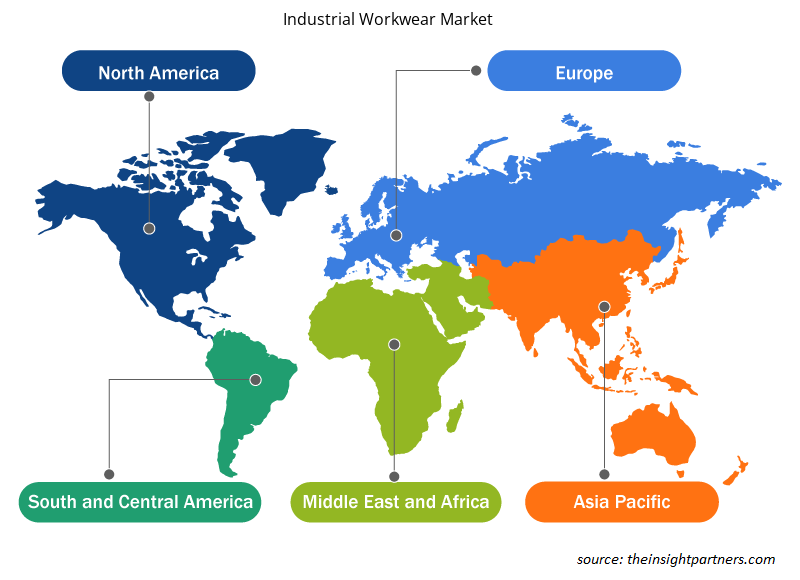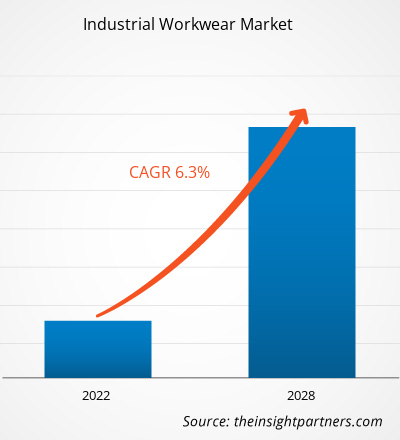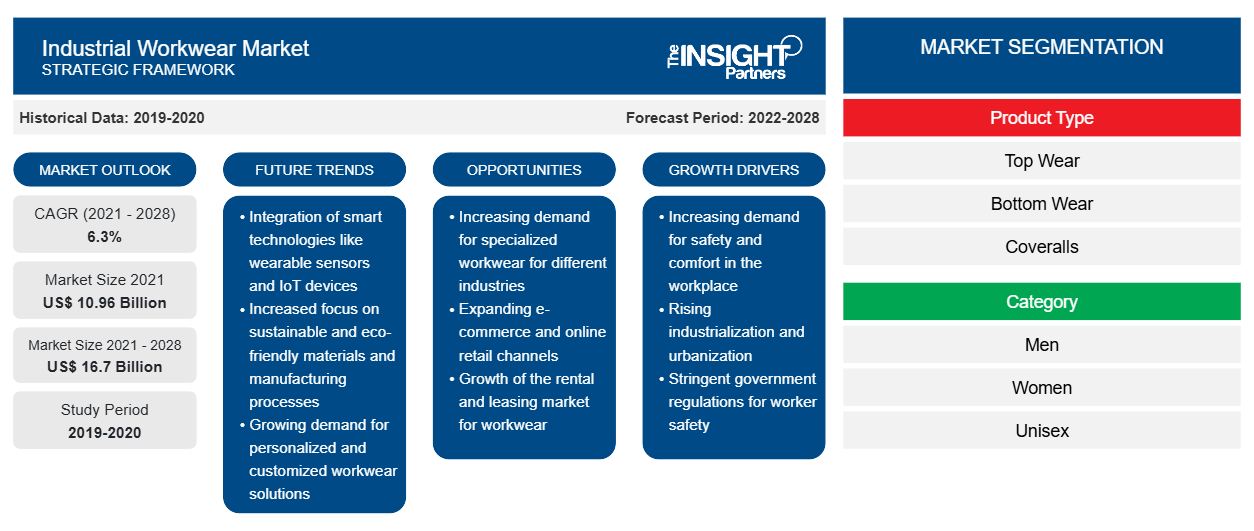من المتوقع أن يصل سوق ملابس العمل الصناعية إلى 16،697.49 مليون دولار أمريكي بحلول عام 2028 من 10،956.69 مليون دولار أمريكي في عام 2021. ومن المتوقع أن ينمو بمعدل نمو سنوي مركب قدره 6.3٪ من عام 2022 إلى عام 2028.
توفر ملابس العمل الصناعية السلامة للعمال وتضمن بيئة عمل صحية. تُستخدم ملابس العمل على نطاق واسع في قطاعات مختلفة، بما في ذلك النفط والغاز والمواد الكيميائية والبناء والتصنيع والسيارات والزراعة والتعدين. على مدار السنوات القليلة الماضية، زادت مخاوف سلامة العمال بين القطاعات الصناعية بسرعة. تفرض العديد من الحكومات وجمعيات السلامة إرشادات صناعية لضمان سلامة العمال، مما أدى إلى زيادة الطلب على ملابس العمل.
في عام 2020، استحوذت أمريكا الشمالية على أكبر حصة من سوق ملابس العمل الصناعية العالمية ، ومن المتوقع أن تسجل منطقة آسيا والمحيط الهادئ أعلى معدل نمو سنوي مركب خلال فترة التوقعات. تشهد البلدان الناشئة في منطقة آسيا والمحيط الهادئ، بما في ذلك الصين والهند، زيادة في تدابير ونفقات السلامة في العمل، مما يوفر فرصًا كبيرة للاعبين الرئيسيين في السوق. تعد منطقة آسيا والمحيط الهادئ سوقًا بارزًا لملابس العمل الصناعية بسبب العدد المتزايد من الحوادث المهنية والبنية التحتية الرديئة والمبادرات الرامية إلى الحد من معدلات الوفيات في مكان العمل. وفقًا لمنظمة العمل الدولية (ILO)، في تقريرها المنشور عام 2021، يتم تسجيل أكثر من 1.1 مليون حالة وفاة في منطقة آسيا والمحيط الهادئ بسبب الحوادث المهنية أو الأمراض المرتبطة بالعمل سنويًا. تتمتع دول مثل الهند بأقل قوة عاملة محمية وأقلها إعلامًا وأقلها تدريبًا. تعد النساء والأطفال والعمال المعوقون والعمال المهاجرون والأقليات العرقية من بين أكثر السكان تضررًا وغالبًا ما يتعرضون لحوادث مهنية. وبالتالي، لتقليل الحوادث والإصابات المهنية، تستثمر صناعات البناء والتصنيع والنفط والغاز والعديد من الصناعات على نطاق واسع في سلامة عمل موظفيها. ومن ثم، فإن الوعي المتزايد فيما يتعلق بسلامة العمل يدفع الطلب على ملابس العمل الصناعية في منطقة آسيا والمحيط الهادئ.
قم بتخصيص هذا التقرير ليناسب متطلباتك
ستحصل على تخصيص لأي تقرير - مجانًا - بما في ذلك أجزاء من هذا التقرير، أو تحليل على مستوى الدولة، وحزمة بيانات Excel، بالإضافة إلى الاستفادة من العروض والخصومات الرائعة للشركات الناشئة والجامعات
-
احصل على أهم اتجاهات السوق الرئيسية لهذا التقرير.ستتضمن هذه العينة المجانية تحليلاً للبيانات، بدءًا من اتجاهات السوق وحتى التقديرات والتوقعات.
تأثير جائحة كوفيد-19 على سوق ملابس العمل الصناعية
أعاقت جائحة كوفيد-19 والإغلاقات الممتدة الطلب على منتجات ملابس العمل الصناعية في مختلف القطاعات، بما في ذلك النفط والغاز والبناء والتصنيع والسيارات والمواد الكيميائية. تُستخدم ملابس العمل الصناعية في مختلف القطاعات الصناعية لضمان سلامة العمال في مكان العمل. ومع ذلك، واجهت صناعة ملابس العمل الصناعية تحديات غير مسبوقة أثناء تفشي كوفيد-19 في عام 2020. واجه مصنعو ملابس العمل الصناعية تحديات كبيرة بسبب قيود سلسلة التوريد الناجمة عن عمليات الإغلاق على مستوى البلاد وحظر التجارة وقيود السفر. تسببت الاضطرابات في سلاسل التوريد في نقص المواد الخام، مما أثر على إنتاج وتوزيع منتجات ملابس العمل الصناعية المختلفة.
في عام 2021، استأنفت العديد من الاقتصادات والصناعات عملياتها بعد أن أعلنت الحكومات تخفيف القيود المفروضة سابقًا. وتم السماح للمصنعين بالعمل بكامل طاقتهم، مما ساعدهم على التغلب على فجوات العرض والطلب. وبالتالي، ركز مصنعو ملابس العمل على زيادة إنتاجهم لإحياء أعمالهم.
رؤى السوق
إدخال لوائح حكومية صارمة يحرك سوق ملابس العمل الصناعية
إن الافتقار إلى المعرفة فيما يتعلق بسلامة مكان العمل والمخاطر الصحية المحتملة في أماكن العمل بين العمال يشكل مصدر قلق كبير في جميع أنحاء العالم. ولزيادة الوعي بهذا الأمر، تقدم العديد من المنظمات الحكومية وغير الحكومية برامج وحملات مختلفة تتعلق بصحة وسلامة العمال. ووفقًا لمنظمة المعايير الأمريكية، في أمريكا الشمالية، تقوم وزارة العمل الأمريكية وإدارة السلامة والصحة المهنية (OSHA) بتوحيد معايير السلامة والصحة المهنية. تشمل المنظمات المشاركة في تطوير معايير الملابس الواقية الجمعية الأمريكية للاختبار والمواد (ASTM)، والجمعية الوطنية للحماية من الحرائق (NFPA)، والمعهد الوطني للسلامة والصحة المهنية (NIOSH)، والمعهد الوطني الأمريكي للمعايير (ANSI)، والجمعية الأمريكية لكيميائيي المنسوجات والملونين (AATCC)، وجمعية معدات السلامة الصناعية (ISEA). وبالتالي، من المتوقع أن يؤدي إدخال مثل هذا التنظيم الحكومي الصارم لتبني ملابس العمل الصناعية لضمان السلامة إلى دفع نمو السوق.
رؤى حول نوع المنتج
بناءً على نوع المنتج، يتم تقسيم سوق ملابس العمل الصناعية إلى ملابس علوية وملابس سفلية وبدلات عمل. سيحتفظ قطاع الملابس العلوية بأكبر حصة في السوق خلال فترة التنبؤ. ومع ذلك، من المتوقع أن يسجل قطاع بدلات العمل أعلى معدل نمو سنوي مركب خلال فترة التنبؤ. بدلات العمل عبارة عن قطعتين من الملابس يتم ارتداؤها لحماية الجسم البشري بالكامل في مكان العمل. تصنع هذه البدلات بشكل أساسي من ألياف النايلون والقطن والبولي أميد. تُستخدم بشكل عام في مصانع وصناعات المعالجة الكيميائية، مثل الدهانات والطلاء والنفط والغاز، نظرًا لارتفاع مخاطر المخاطر المهنية. إنها تحمي العمال من المخاطر الكيميائية والميكانيكية والحرارية والبيولوجية. علاوة على ذلك، فإن السلامة المهنية المتزايدة والوعي بها، بمساعدة اللوائح التي وضعتها الهيئات الحاكمة، دفعت بشكل كبير الطلب على ملابس العمل الصناعية.
رؤى الفئة
بناءً على الفئة، يتم تقسيم سوق ملابس العمل الصناعية إلى رجال ونساء وجنسين. سيستحوذ قطاع الرجال على أكبر حصة من السوق خلال فترة التنبؤ، في حين من المتوقع أن يسجل قطاع الجنسين أعلى معدل نمو سنوي مركب خلال فترة التنبؤ. وفقًا لتقرير مجموعة البنك الدولي لشهر يونيو 2022، بلغت مشاركة القوى العاملة من الذكور 72٪ في عام 2021 في جميع أنحاء العالم. نظرًا لأن معظم الرجال يعملون في قطاعات صناعية وشركات مختلفة، فإن الطلب على ملابس العمل الصناعية آخذ في الازدياد. علاوة على ذلك، وفقًا لتقرير منظمة الصحة العالمية الصادر في 17 سبتمبر 2021، توفي ما يقرب من 2 مليون رجل لأسباب متعلقة بالعمل. وبالتالي، لحماية القوى العاملة من الإصابات والوفيات المهنية، يركز المصنعون على التقنيات الجديدة، مثل ملابس العمل الصناعية المقاومة للهب والمعزولة. يساعد استخدام مثل هذه الملابس في تقليل عدد الوفيات والإصابات المهنية.
رؤى الاستخدام النهائي
بناءً على الاستخدام النهائي، يتم تقسيم سوق ملابس العمل الصناعية إلى النفط والغاز والبناء والمواد الكيميائية والسيارات والتصنيع وغيرها. شكل قطاع التصنيع أكبر حصة سوقية في عام 2020. السبب الرئيسي للحوادث الصناعية في قطاع التصنيع هو التعرض المستمر للعمال لبيئة عمل خطيرة وعدم توفر أحذية واقية للعمال مما يؤدي إلى حدوث إصابات. تم تصميم بدلات الحماية والقفازات والأكمام والقبعات والمعاطف والسترات والقمصان والجوارب والسترات الناعمة والسترات الصوفية والسراويل وأقنعة الوجه ودروع الوجه والسترات والأحذية الواقية والأحذية ذات مقدمة الحذاء الواقية خصيصًا لحماية وصيانة الجزء العلوي والسفلي من الجسم.
تعد كل من Carhartt, Inc. وALSICO وA.LAFONT SAS وHoneywell International Inc. وHultafors Group وLakeland Inc وAramark وAnsell Ltd. وVF Corporation وMustang Workwear من بين اللاعبين الرئيسيين العاملين في سوق ملابس العمل الصناعية. وتؤكد هذه الشركات على إطلاق منتجات جديدة والتوسع الجغرافي لتلبية الطلب المتزايد من المستهلكين في جميع أنحاء العالم. ولديها حضور عالمي واسع النطاق، مما يتيح لها خدمة مجموعة كبيرة من العملاء من جميع أنحاء العالم وبالتالي زيادة حصتها في السوق. وتركز هذه الشركات في السوق بشكل كبير على إطلاق منتجات جديدة والتوسع الإقليمي لزيادة نطاق منتجاتها في محافظ المنتجات المتخصصة.
رؤى إقليمية حول سوق ملابس العمل الصناعية
لقد قام المحللون في Insight Partners بشرح الاتجاهات والعوامل الإقليمية المؤثرة على سوق ملابس العمل الصناعية طوال فترة التوقعات بشكل شامل. يناقش هذا القسم أيضًا قطاعات سوق ملابس العمل الصناعية والجغرافيا في جميع أنحاء أمريكا الشمالية وأوروبا ومنطقة آسيا والمحيط الهادئ والشرق الأوسط وأفريقيا وأمريكا الجنوبية والوسطى.

- احصل على البيانات الإقليمية المحددة لسوق ملابس العمل الصناعية
نطاق تقرير سوق ملابس العمل الصناعية
| سمة التقرير | تفاصيل |
|---|---|
| حجم السوق في عام 2021 | 10.96 مليار دولار أمريكي |
| حجم السوق بحلول عام 2028 | 16.7 مليار دولار أمريكي |
| معدل النمو السنوي المركب العالمي (2021 - 2028) | 6.3% |
| البيانات التاريخية | 2019-2020 |
| فترة التنبؤ | 2022-2028 |
| القطاعات المغطاة |
حسب نوع المنتج
|
| المناطق والدول المغطاة |
أمريكا الشمالية
|
| قادة السوق وملفات تعريف الشركات الرئيسية |
|
كثافة اللاعبين في سوق ملابس العمل الصناعية: فهم تأثيرها على ديناميكيات الأعمال
يشهد سوق ملابس العمل الصناعية نموًا سريعًا، مدفوعًا بالطلب المتزايد من المستخدم النهائي بسبب عوامل مثل تفضيلات المستهلكين المتطورة والتقدم التكنولوجي والوعي المتزايد بفوائد المنتج. ومع ارتفاع الطلب، تعمل الشركات على توسيع عروضها والابتكار لتلبية احتياجات المستهلكين والاستفادة من الاتجاهات الناشئة، مما يؤدي إلى زيادة نمو السوق.
تشير كثافة اللاعبين في السوق إلى توزيع الشركات أو المؤسسات العاملة في سوق أو صناعة معينة. وهي تشير إلى عدد المنافسين (اللاعبين في السوق) الموجودين في مساحة سوق معينة نسبة إلى حجمها أو قيمتها السوقية الإجمالية.
الشركات الرئيسية العاملة في سوق ملابس العمل الصناعية هي:
- كارهات، المحدودة
- أرامارك
- مجموعة السيكو
- أ. لافونت ساس
- شركة هونيويل الدولية
إخلاء المسؤولية : الشركات المذكورة أعلاه ليست مرتبة بأي ترتيب معين.

- احصل على نظرة عامة على أهم اللاعبين الرئيسيين في سوق ملابس العمل الصناعية
تقرير يسلط الضوء على
- اتجاهات الصناعة التقدمية في سوق ملابس العمل الصناعية لمساعدة الشركات على تطوير استراتيجيات فعالة طويلة الأجل
- استراتيجيات نمو الأعمال التي يتبناها لاعبو سوق ملابس العمل الصناعية في البلدان المتقدمة والنامية
- التحليل الكمي للسوق من 2020 إلى 2028
- تقدير الطلب العالمي على ملابس العمل
- تحليل قوى بورتر الخمس لتوضيح فعالية المشترين والموردين في سوق ملابس العمل الصناعية
- التطورات الأخيرة لفهم سيناريو السوق التنافسي
- اتجاهات السوق وتوقعاته، فضلاً عن العوامل التي تدفع وتكبح نمو سوق ملابس العمل الصناعية
- المساعدة في عملية اتخاذ القرار من خلال تسليط الضوء على استراتيجيات السوق التي تدعم المصلحة التجارية
- حجم سوق ملابس العمل الصناعية في مختلف العقد
- نظرة عامة مفصلة وديناميكيات صناعة ملابس العمل الصناعية
- حجم سوق ملابس العمل الصناعية في مختلف المناطق مع فرص نمو واعدة
- التحليل التاريخي (سنتان)، سنة الأساس، التوقعات (7 سنوات) مع معدل النمو السنوي المركب
- تحليل PEST و SWOT
- حجم السوق والقيمة / الحجم - عالمي، إقليمي، بلد
- الصناعة والمنافسة
- مجموعة بيانات إكسل
التقارير الحديثة
تقارير ذات صلة
شهادات العملاء
سبب الشراء
- اتخاذ قرارات مدروسة
- فهم ديناميكيات السوق
- تحليل المنافسة
- رؤى العملاء
- توقعات السوق
- تخفيف المخاطر
- التخطيط الاستراتيجي
- مبررات الاستثمار
- تحديد الأسواق الناشئة
- تحسين استراتيجيات التسويق
- تعزيز الكفاءة التشغيلية
- مواكبة التوجهات التنظيمية























 احصل على عينة مجانية ل - سوق ملابس العمل الصناعية
احصل على عينة مجانية ل - سوق ملابس العمل الصناعية